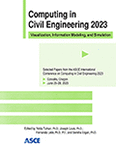Deep Learning Method to Detect and Locate Signages from 2D Drawings for Semantic Enrichment of BIM
Publication: Computing in Civil Engineering 2023
ABSTRACT
A reasonable signage layout can reduce evacuees’ operational delays during emergencies. Building information modeling (BIM) with detailed signage information is essential for automatic checking and improving the signage layout. However, in current practice, exit signs of buildings are presented mostly in 2D drawing formats rather than in BIM. Manually adding these signages into BIM is time-consuming and labor-intensive, and reconstructing them with on-site data requires considerable device costs and workload. Hence, there is a need for a convenient, low-cost, and widely applicable approach to extract signage information from 2D drawings and add them into BIM. Related works on 2D drawings mainly focused on architectural and structural components, but those methods cannot directly apply to exit signs. This study proposes a deep learning method combined with pre-set rules to detect and locate exit signs from 2D drawings. The extracted information is expected to enrich existing building models.
Get full access to this article
View all available purchase options and get full access to this chapter.
REFERENCES
Belsky, M., R. Sacks, and I. Brilakis. (2016). “Semantic Enrichment for Building Information Modeling.” Comput.-Aided Civ. Infrastruct. Eng. 31(4): 261–274.
Bloch, T., and R. Sacks. (2018). “Comparing machine learning and rule-based inferencing for semantic enrichment of BIM models.” Automation in Construction 91: 256–272.
Cho Chi, Y., and X. Liu. (2017). “An Automated Reconstruction Approach of Mechanical Systems in Building Information Modeling (BIM) Using 2D Drawings.” Computing in Civil Engineering 2017: 236–244.
Dimyadi, J. (2021). A Systematic Review of Automated BIM Modelling for Existing Buildings from 2D Documentation. Proceedings of the 38th International Symposium on Automation and Robotics in Construction (ISARC), International Association for Automation and Robotics in Construction (IAARC): 220–226.
Fu, M., and R. Liu. (2020). “An approach of checking an exit sign system based on navigation graph networks.” Advanced Engineering Informatics 46.
Fu, M., and R. Liu. (2020). “BIM-based automated determination of exit sign direction for intelligent building sign systems.” Automation in Construction 120.
Gimenez, L., S. Robert, F. Suard, and K. Zreik. (2016). “Automatic reconstruction of 3D building models from scanned 2D floor plans.” Automation in Construction 63: 48–56.
Kim, K., and M. Peavy. (2022). “BIM-based semantic building world modeling for robot task planning and execution in built environments.” Automation in Construction 138.
Lu, Q., and S. Lee. (2017). “A Semi-Automatic Approach to Detect Structural Components from CAD Drawings for Constructing As-Is BIM Objects.” Computing in Civil Engineering 2017: 84–91.
Pan, Y., A. Braun, I. Brilakis, and A. Borrmann. (2022). “Enriching geometric digital twins of buildings with small objects by fusing laser scanning and AI-based image recognition.” Automation in Construction 140: 104375.
Reja, V. K., K. Varghese, and Q. P. Ha. (2022). “Computer vision-based construction progress monitoring.” Automation in Construction 138.
Rho, J., H.-S. Lee, and M. Park. (2020). “Automated BIM generation using drawing recognition and line-text extraction.” Journal of Asian Architecture and Building Engineering 20(6): 747–759.
Sacks, R., L. Ma, R. Yosef, A. Borrmann, S. Daum, and U. Kattel. (2017). “Semantic Enrichment for Building Information Modeling: Procedure for Compiling Inference Rules and Operators for Complex Geometry.” Journal of Computing in Civil Engineering 31(6).
Singapore Civil Defence Force. (2023). “8.1 Exit lighting and exit sign.” Retrieved 2nd March, 2023, from <https://www.scdf.gov.sg/firecode/table-of-content/chapter-8-emergency-lighting-voice-communicarion-systems/clause-8.1#:~:text=The%20bottom%20of%20the%20low,100mm%20of%20the%20door%20frame>.
Tuttas, S., A. Braun, A. Borrmann, and U. Stilla. (2017). “Acquisition and Consecutive Registration of Photogrammetric Point Clouds for Construction Progress Monitoring Using a 4D BIM.” PFG – Journal of Photogrammetry, Remote Sensing and Geoinformation Science 85(1): 3–15.
Wang, Z., R. Sacks, and T. Yeung. (2022). “Exploring graph neural networks for semantic enrichment: Room type classification.” Automation in Construction 134: 104039.
Wu, Y., J. Shang, P. Chen, S. Zlatanova, X. Hu, and Z. Zhou. (2020). “Indoor mapping and modeling by parsing floor plan images.” International Journal of Geographical Information Science 35(6): 1205–1231.
Zhao, Y., X. Deng, and H. Lai. (2021). “Reconstructing BIM from 2D structural drawings for existing buildings.” Automation in Construction 128: 103750.
Information & Authors
Information
Published In
History
Published online: Jan 25, 2024
ASCE Technical Topics:
- Architectural engineering
- Architecture
- Artificial intelligence and machine learning
- Benefit cost ratios
- Building information modeling
- Building management
- Buildings
- Business management
- Computer programming
- Computing in civil engineering
- Detection methods
- Disaster preparedness
- Disaster risk management
- Emergency management
- Employment
- Engineering fundamentals
- Financial management
- Labor
- Methodology (by type)
- Neural networks
- Personnel management
- Practice and Profession
- Structural engineering
- Structures (by type)
Authors
Metrics & Citations
Metrics
Citations
Download citation
If you have the appropriate software installed, you can download article citation data to the citation manager of your choice. Simply select your manager software from the list below and click Download.
